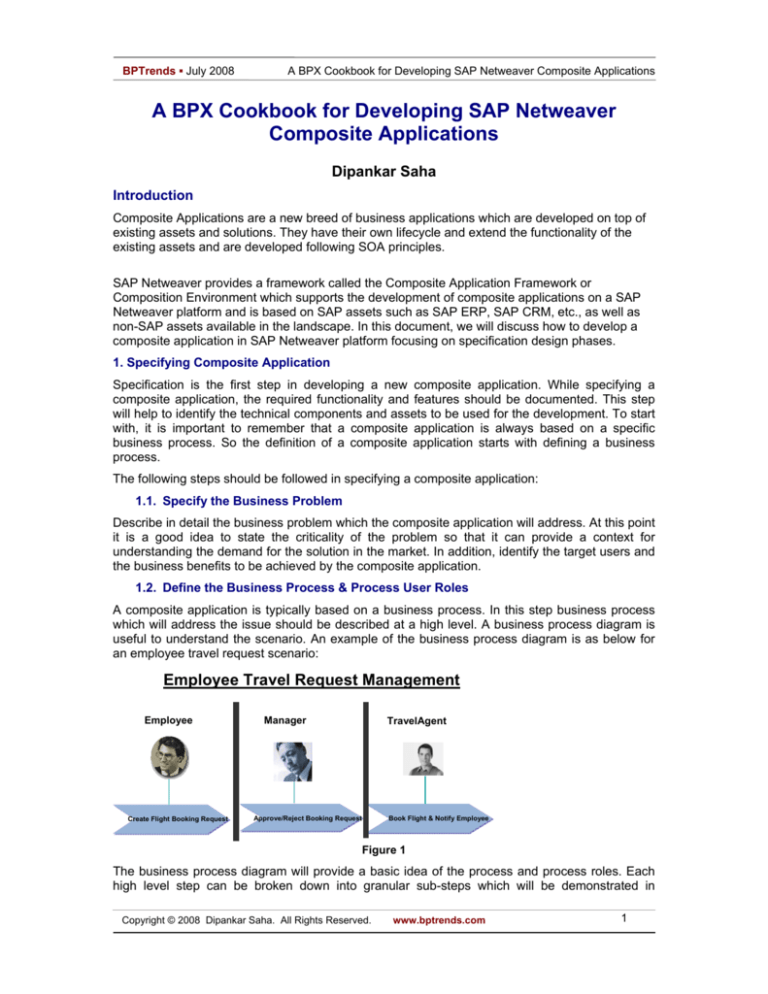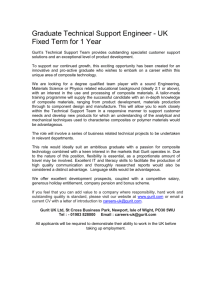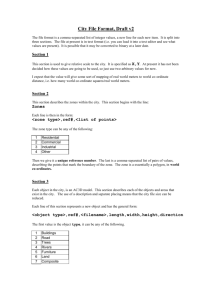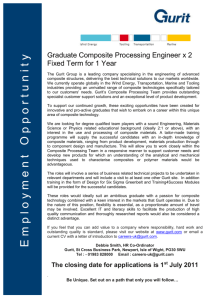
BPTrends ▪ July 2008
A BPX Cookbook for Developing SAP Netweaver Composite Applications
A BPX Cookbook for Developing SAP Netweaver
Composite Applications
Dipankar Saha
Introduction
Composite Applications are a new breed of business applications which are developed on top of
existing assets and solutions. They have their own lifecycle and extend the functionality of the
existing assets and are developed following SOA principles.
SAP Netweaver provides a framework called the Composite Application Framework or
Composition Environment which supports the development of composite applications on a SAP
Netweaver platform and is based on SAP assets such as SAP ERP, SAP CRM, etc., as well as
non-SAP assets available in the landscape. In this document, we will discuss how to develop a
composite application in SAP Netweaver platform focusing on specification design phases.
1. Specifying Composite Application
Specification is the first step in developing a new composite application. While specifying a
composite application, the required functionality and features should be documented. This step
will help to identify the technical components and assets to be used for the development. To start
with, it is important to remember that a composite application is always based on a specific
business process. So the definition of a composite application starts with defining a business
process.
The following steps should be followed in specifying a composite application:
1.1. Specify the Business Problem
Describe in detail the business problem which the composite application will address. At this point
it is a good idea to state the criticality of the problem so that it can provide a context for
understanding the demand for the solution in the market. In addition, identify the target users and
the business benefits to be achieved by the composite application.
1.2. Define the Business Process & Process User Roles
A composite application is typically based on a business process. In this step business process
which will address the issue should be described at a high level. A business process diagram is
useful to understand the scenario. An example of the business process diagram is as below for
an employee travel request scenario:
Employee Travel Request Management
Employee
Create Flight Booking Request
Manager
TravelAgent
Approve/Reject Booking Request
Book Flight & Notify Employee
Figure 1
The business process diagram will provide a basic idea of the process and process roles. Each
high level step can be broken down into granular sub-steps which will be demonstrated in
Copyright © 2008 Dipankar Saha. All Rights Reserved.
www.bptrends.com
1
BPTrends ▪ July 2008
A BPX Cookbook for Developing SAP Netweaver Composite Applications
subsequent sections. Also define the user roles for each process step from the business process
diagram.
1.3. Define the Process Steps
The business process described in section 2.2 should be decomposed into granular steps. The
process steps should be depicted in a detailed business process flow diagram as below:
Employee Travel Request Management
Employee
Manager
Travel Desk
1
Search for Flight
2
Create Flight
Booking Request
3
Approve or
Reject
Approve
5
Create Flight
Booking
Approve / Reject
4
Receive
Notification
6
Receive
Confirmation
Figure 2: Employee Travel Request Management
Also describe each of the process steps using the following table format:
Step
No
Step
Title
Step
Description
Interactive
(I) Manor
datory
Background (B)
Due
date Role
handling
required
Exits
Next Step
1
Search Flight
Employee enter the search I
criteria and submit search
Y
N
Employee Default ◊ 2
2
Create
Flight Employee selects a flight I
Booking Request from the list and submit
booking request
Y
N
Employee
3
Decide On Booking Manager decides on the I
Request
Request
Y
Y
(within
hours)
4
Receive
Notification
Employee
decision
receives I
Y
N
5
Book Flight
Clerk updates original order I
Y
Y (within 24 Clerk
hours)
Manager Approved ◊ 4,5
24
Rejected ◊ 4
Employee Default ◊ end
Default ◊ end
Table 1: Description of Process Steps
The above table will help to explain the detail activity for each process step as well as the process
flow information, such as due date handling, subsequent step and whether a step is interactive
(UI based) or a background action.
Copyright © 2008 Dipankar Saha. All Rights Reserved.
www.bptrends.com
2
BPTrends ▪ July 2008
A BPX Cookbook for Developing SAP Netweaver Composite Applications
1.4. Define the User Interfaces
The user interfaces for each interactive process step should be specified using screen mock-ups.
This will help while designing and developing the user interface.
The above steps will specify the composite application features and functions at a high level and
should be typically performed by the Business Analysts or the Business Process Experts.
The Guidelines for Specifying Composite Applications is a good resource provided by SAP to
capture the specification of a composite application being developed.
2. Designing Composite Application
After the specification of the composite application is complete, the design phase is started. In the
next steps, the process is decomposed into granular blocks, and the underlying services are
identified.
2.1. Service Identification
Composite applications are based on services and follow SOA principles. Each process or
process step is typically based on a service. Identify the coarse-grained services underlying each
process step. For example, Create Travel Booking Request is a service performed in first step of
the composite application. These are the composite services that comprise the total business
functionality. Include all the identified services following the example in the table below:
Service Name
Description
CreateTravelBookingRequest
Creates a flight booking request
ApproveTravelBookingRequest
Approves or rejects a travel booking request
CreateTravelBooking
Creates a flight booking based on the request
Table 2: List of Identified Services
2.2. Service Decomposition
In the next step, decompose the above composite services into granular atomic services if
possible. An identified service may perform a set of activities which are executed by a series of
atomic services. Include all the atomic services for each composite service as in the table below.
Also specify the input, output and exception handling logic for each of the services:
Composite Service
Atomic Services
Description
Input
Output
Exception
Handling
CreateTravelBookingRequest
SearchFlight
Search Flight
Start date,
end date
Flight List
Start date
earlier than
end date
CheckEmployeeEligibility
Checks
the
employee eligibility
for the selected flight
employeeID
Flight
class
Employee
ID is valid
CreateTravelBookingRequest
Creates
request
Flight
ID,
dates,
employee
ID,
comments
Booking
ID
Flight ID,
employee
ID
and
dates are
valid
SubmitTravelBookingRequest
Submit the booking
Booking ID
Status,
Booking ID
Copyright © 2008 Dipankar Saha. All Rights Reserved.
a
www.bptrends.com
booking
3
BPTrends ▪ July 2008
A BPX Cookbook for Developing SAP Netweaver Composite Applications
request for approval
ApproveTravelBookingReque
st
CreateTravelBooking
approver
is valid
ReviewTravelBookingRequest
Reviews the booking
request
Booking ID
Booking
details
Booking ID
is valid
ApproveTravelBookingRequest
Approves or rejects
the travel request
Booking ID
Confirmati
on
Booking ID
is
valid,
status
is
Created
BookFlightForEmployee
Books a flight for the
employee
Booking ID
Booking
Confirmati
on
Booking ID
is
valid,
status
is
Approved
UpdateBookingRequest
Updates the booking
request with booking
details
Booking ID,
flight
confirmation
Confirmati
on, status
Booking ID
is
valid,
status
is
Approved
CreateInvoice
Creates invoice for
the flight booking
Booking ID,
invoice
details
Invoice
number
Booking ID
is
valid,
status
is
Booked
NotifyEmployee
Notifies
employee
Booking ID
Confirmati
on
Booking ID
is
valid,
status
is
Booked
the
Table 3: Composite Services Decomposed into Atomic Services
2.3. Service Mapping
In the next step, map each atomic service identified in section 2.2 to services from existing assets
wherever available as in the following table. Existing assets can be enterprise systems such as
SAP ERP, SAP CRM or legacy, etc. Wherever a corresponding service is not available from any
existing asset, it should be provided by the composite application, i.e. the services should be
developed in the composite application. You can use the SDN ES WorkPlace or the Service
Registry installed in your local environment to learn the Enterprise Services available, which can
be used in the composite application. The Enterprise Services are grouped in the SDN ES
Workplace in a hierarchy of Deployment Units, Process Components and Service Interfaces
which are referenced by the SAP solution maps. Start with a solution map in ES Workplace for
the corresponding business scenario address by the composite application and drill down to find
the relevant Enterprise Services. Refer the following document on how to explore the ES
Workplace:
ES Workplace Handbook
Also if an existing service does not support the full business functionality required by the
composite application or if multiple existing services provide the actual functionality required, the
existing service functionality can be extended as well multiple services can be composed in the
CAF Core layer.
Also you can refer to the following documents for more information on how to configure and
publish enterprise services in the Netweaver CE 7.1 UDDI registry:
Configuring & Publishing Enterprise Services from SAP Business Suite system into NWCE
(Netweaver Composition Environment) Services Registry
Configuring the Services Registry
Services Registry
Copyright © 2008 Dipankar Saha. All Rights Reserved.
www.bptrends.com
4
BPTrends ▪ July 2008
A BPX Cookbook for Developing SAP Netweaver Composite Applications
If the required Enterprise Service is not available currently, BAPI or RFC can be used which may
provide the corresponding business functionality.
Atomic Service
Type
Provider
Provider Service
Existing/New
SearchFlight
RFC/BAPI
SAP ECC
BAPI_FLIGHT_GETLIST
Existing
CheckEmployeeEligibility
Web
Service
SAP ECC
ECC_ReadEmployeeByIdQR
Existing
CreateBookingRequest
Web
Service
TravelManagement
(Composite)
CreateBookingRequestForEmployee
New
Table 4: Mapping Atomic Services
2.4. Defining the Business Objects
Define the business objects used in the process. Each service is consumed by a Business
Object, i.e. an atomic service is an operation of a business object. Some business objects are
available in the backend while some are custom business objects to be modelled in the
composite layer. The source of the business objects should be specified along with the
persistency. Also, the attributes of the business objects should be defined here.
Business
Object/Entity
Descripti
on
Employee
Business
Object
for
employe
e
Booking
Request
Business
Object
for travel
booking
request
Attributes
Datatype
Custom findBy
Methods
Related
BO/Entity
Association Type
Persistency
Backend
employeeID
String
findByEmployeeID
BookingRequest
Composition
Remote
SAP ECC
employeeName
String
employeeDepart
ment
String
findByEmployeeDept
requestID
String
findByRequestID
Local
NA
requestText
String
findRequestByEmplo
yeeID
requestType
String
flightNumber
String
findByStatus
startDate
DateTime
findByTravelDate
endDate
DateTime
status
String
Table 5: Defining Business Objects
The Business Objects defined above are the Entity Services in Netweaver 7.0 and Business
Objects in Netweaver CE. The related Business Objects/Entity also must be specified here along
with the association type. For details on association and composition of BOs in Netweaver CE
7.1, refer the following SDN blog:
Modeling Business Objects in Netweaver CE CAF Core
It is not recommended to model the remote business objects/entity in the composite layer. For
business objects/entities which exist in the backend/existing assets, the services for the same
Copyright © 2008 Dipankar Saha. All Rights Reserved.
www.bptrends.com
5
BPTrends ▪ July 2008
A BPX Cookbook for Developing SAP Netweaver Composite Applications
should be directly consumed in the composite layer as external services. Modeling remote
business objects/entities in the composite layer will increase complexity, and some scenarios
may not be supported.
Also the Business Objects/Entity should be represented in an E-R diagram as below:
<<entity>>
1
0..n
Employee
<<entity>>
BookingRequest
1..n
*
<<entity>>
BOx
<<entity>>
BOy
1
Figure 3: Business Objects Diagram
2.5. Service Specification
Specify the services needs to be developed in the composite application with the relevant
details of service operations, input, output, exception handling and dependent service details.
Atomic services which are defined and mapped with external services in section 2.2 and
section 2.3 are the operations of the services developed in the composite layer. Group the
relevant atomic services as operations of a composite service and specify each of them as in
the following table. These services have to be developed in the CAF Core layer as
application services, which will provide the business functionalities offered by the composite
application.
Service 1: ManageFlightBookingRequest
Operations
Description
Input
Output
Exception
Handling
Dependent
Service
SearchFlight
Search Flight
Start date,
end date
Flight
List
Start date earlier
than end date
BAPI_FLIGHT_GETLIST
CreateBookingRequest
Creates a booking
request
Flight ID,
dates,
employee
ID,
comments
Booking
ID
Flight ID,
employee ID
and dates are
valid
Web Service
ManageFlightBookingWS
None
Table 6: Specifying the Composite Services
Copyright © 2008 Dipankar Saha. All Rights Reserved.
www.bptrends.com
6
BPTrends ▪ July 2008
A BPX Cookbook for Developing SAP Netweaver Composite Applications
2.6. Designing the Process
The process steps identified in section 1.3 along with the services and user interfaces identified in
section 1.4 define the composite process which will be developed using Guided Procedure.
Specify the process blocks along with the actions and callable objects to be developed in Guided
Procedure in the table format as below:
Block Name
Block Type
Action
Callable Object
CO Type
ResultState
Target
CreateTravelRequestAC
CreateTravelRequest
CO
Web
Dynpro
Java
(GP Interface)
Submit
ApproveTravelReque
stAC
Cancel
TerminateProcessAC
Success
End
Web
Dynpro
Java
(GP Interface)
Approve
CreateFlightBookingA
C
Reject
SendRejectionMailAC
Sequential
Block
CreateTravelRequest
TerminateProcessAC
ApproveTravelReque
st
Sequential
Block
ApproveTravelRequestA
C
TerminateProcessCO
ApproveTravelReque
stCO
SendRejectionMailAC
SendRejectionMailCO
Send Notification
Success
TerminateProcessAC
CreateFlightBookingAC
CreateFlightBookingC
O
Web
Dynpro
Java
(GP Interface)
Success
NotifyBookingDetailsA
C
Failure
CreateTravelRequest
AC
Success
No Target
Sequential
Block
CreateFlightBooking
Terminate
Process
(Process
Control)
NotifyBookingDetailsAC
NotifyBookingDetails
CO
Send Notification
Table 7: Defining the Process
3. Architecture of the Composite Application
A composite application can have the following components:
•
CAF Core as composite service layer
•
Web Dynpro/ Visual Composer/Adobe Interactive Forms as user interface layer
•
Guided Procedure as process layer
The following diagram explains the architecture of a composite application in the SAP Netweaver
platform:
Copyright © 2008 Dipankar Saha. All Rights Reserved.
www.bptrends.com
7
BPTrends ▪ July 2008
A BPX Cookbook for Developing SAP Netweaver Composite Applications
Role 1
Role 2
Role 3
COMPOSITE APPLICATION
Workcenter
Step 1
Step 2
Step 3
Step 4
Business
Process
Actions
UI
Remote
Services
Adobe Int.
Form
UI WebDynpro UI
Business Objects
Remote
Local
Visual
Composer
User Interfaces
Business Objects,
Services
Local
Services
CAF-Core
Exchange
Infrastructure
BACKEND
(optional)
RFC/BAPI
WebServices
Services
Services
Services
CRM
BW
ERP
DB
Services
Actions
Existing Systems
DB
BO model
Service Enablement
DB
Database
Figure 4: Architecture of a Composite Application
The backend systems are the enterprise systems, such as SAP ERP, SAP CRM, SAP BI, etc. as
well as non-SAP and legacy systems which provide existing business functionality as services
that are consumed by the composite layer, i.e. CAF Core and new composite service are
developed over them. The composite services are consumed by the user interfaces which are
part of the actions or process steps in the Guided Procedure. It is always a good practice to
consume the backend service in the CAF layer only and not directly in the user interface layer.
4. Tools and Platform for Developing Composite Applications
SAP has released a new platform called SAP Netweaver Composition Environment 7.1 which
provides the tools and technologies for development of composite applications in a model-driven
development environment. The salient features of Netweaver CE are:
•
Enterprise Service Repository and Services Registry for provisioning, discovering and
consuming Enterprise Services by composite applications
•
Enhanced CAF Core layer supporting Java EE 5
•
Web Dynpro Java for development of user interfaces
•
Enhanced Visual Composer for development of user interfaces supporting Web Dynpro
as well as Flex runtimes. Visual Composer in Netweaver CE can also be used to model
Enterprise Portal Content, develop voice-enabled applications.
Copyright © 2008 Dipankar Saha. All Rights Reserved.
www.bptrends.com
8
BPTrends ▪ July 2008
A BPX Cookbook for Developing SAP Netweaver Composite Applications
•
Adobe Interactive forms as Composite forms to be used in Guided Procedure and Web
Dynpro user interfaces
•
Guided Procedure with enhanced features to model composite collaborative processes.
Figure 5: Composition Capability Provided By SAP Netweaver Platform
Netweaver 7.0 along with Netweaver CE 7.1 can provide the service provisioning as well as the
composition platform for SAP Netweaver composite applications. Enterprise applications such as
SAP ERP, CRM, SCM run on Netweaver 7.0, which uses the service provisioning layer to provide
the Enterprise Services defined in Enterprise Service Repository, provided in Netweaver CE 7.1.
The Enterprise Services are published in the Services Registry and are consumed by the
composite layer in Netweaver CE 7.1. The figure below explains the platform architecture.
Copyright © 2008 Dipankar Saha. All Rights Reserved.
www.bptrends.com
9
BPTrends ▪ July 2008
A BPX Cookbook for Developing SAP Netweaver Composite Applications
Federated
Enterprise Portal 7.0 Portal
Network
Enterprise Portal 7.1
Guided Procedure
WebDynpro/Visual Composer/Adobe Forms
Composite Services
Netweaver CE 7.1
CAF Core
Service
Discovery
Service
Consumption
Enterprise Service
Repository
Enterprise Services
Registry
Service Provisioning
Netweaver
7.0
Legacy
SAP SCM
SAP CRM
SAP ERP
Service Provisioning Layer
Service Consumption Layer
Figure 6: Netweaver 7.0 and CE 7.1 as Service Provisioning and Composition Platforms
References
Composite Application Architecture: Introduction and Basic Overview
Composite Application Development Cookbook
Architecture Guideline series for Composite Applications Introduction and Basic Overview
Architecture Guideline Series for Composite Applications Portal and Process Layer
Architecture Guideline Series for Composite Applications Business Logic, Abstraction Layer and
Connectivity
Composition Environment Info Center
CAF Training Materials Online
Additional CAF Training Materials Online
Author
Dipankar Saha is a SAP Certified Enterprise Architect and Advisory system Analyst
at IBM India.
Email: dipankar.saha@in.ibm.com
Dipankar’s SAP Community Network Weblog:
https://www.sdn.sap.com/irj/sdn/weblogs?blog=/pub/u/251760438
Copyright © 2008 Dipankar Saha. All Rights Reserved.
www.bptrends.com
10








